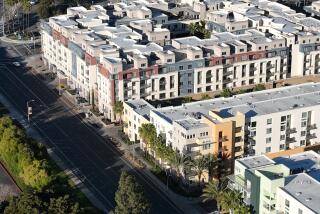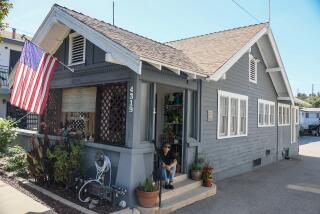Imposes New Fees on Builders in Urban Areas : City Council Ducks Tough Controls on Growth
The San Diego City Council postponed action Tuesday on stringent proposals to control growth, but voted to charge developers fees for projects in urbanized neighborhoods that are now imposed only in outlying areas of the city.
Under the new policy, the fees will be levied against builders citywide to fund improvements needed because of the increase in population density. They are now used to pay for streets, parks and other urban necessities.
The three-hour session was dominated Tuesday by confusion and concern over the possibility of a building moratorium. But council members unanimously voted to postpone the most sensitive issue--imposition of an emergency ordinance aimed at controlling the city’s runaway growth rate by slowing down residential development.
A five-week delay until June 22 was granted to allow a citizen task force and the city Planning Commission to study development-control methods, including an ordinance devised by the city’s growth control consultant, Robert Freilich, and backed by Mayor Maureen O’Connor.
Verbal Sparring
O’Connor and Councilman Ed Struiksma continued their verbal sparring that began last month over interim development controls. Struiksma has proposed a citywide freeze on issuance of building permits until a case-by-case review determines that public facilities and services are available for each; O’Connor favors a yearly limit on residential building within each of the city’s community planning areas.
City business leaders joined environmental activists in asking for a delay in adoption of Freilich’s hastily written interim ordinance, which is designed to cut residential growth rates by about 50% compared to last year’s record building pace.
Struiksma, who has not submitted his development-control plans in ordinance form, became angry at O’Connor’s repeated attempts to identify his proposal as a “moratorium” or “freeze,” and countered by accusing O’Connor of being “unable to grasp the concept” of his proposal.
O’Connor then asked the audience in the crowded council chambers if they were concerned that there would be a building moratorium imposed in the next 30 days, and a majority said yes.
Ron Roberts, chairman of the citizens’ committee on growth management and of the city Planning Commission, said that the committee was handed Freilich’s ordinance last week and the members were expected to analyze it immediately, despite the fact that “some of the figures didn’t add up, . . . many key pages were missing . . . it was changed during the meeting, continually revised.”
Freilich defended the need for haste by pointing out that building this year “will be far greater than your all-time high” development level of 1986, and any long-term development controls will be offset by overbuilding by developers seeking to avoid future restrictions that might be imposed in tightening up the city’s Growth Management Plan.
Moratorium Warning
He predicted that, if the city’s development pace is not slowed through controls now, “you will have to have a moratorium in the near future.”
Freilich warned that, if the City Council does not act soon, citizens may take the initiative and demand a total moratorium.
“I must be in the ballpark,” Freilich said about his interim growth control ordinance, “because I’m being criticized by both sides.”
The purpose of the ordinance is to prevent a rush of interim development that would render future growth control measures meaningless.
Struiksma and O’Connor agree that some sort of a development limitation is necessary, but Struiksma espouses a citywide cap while O’Connor thinks a neighborhood by neighborhood limit is the fair way to distribute building permits.
Freilich’s proposed ordinance would regulate only residential development and would take effect immediately upon passage. It would exempt low-income housing projects, single-lot development, and certain redevelopment areas (including downtown) from the building limits.
Under Freilich’s complicated formula, North Park would be permitted 467 building permits per year; the Mid-City area, 656; Mission Valley, 595; Pacific Beach, 293; Peninsula (Point Loma, Loma Portal), 396; Southeast San Diego, 472, and the Uptown Community Plan area, 199.
Clairemont Mesa, Mission Beach, Ocean Beach and the San Diego State University areas, already overbuilt, would be permitted no residential building, while La Jolla Shores would be limited to three permits a year, La Jolla to two permits and the Otay Mesa-Nestor area to one.
On the urban fringes of the city, housing activity will be allowed to continue at a relatively fast pace. The Otay Mesa area leads with 891 units permitted each year, followed by North City West, with 817. The North and South University City planning areas would be allowed 545 units per year; Mira Mesa, 582; Rancho Bernardo, 350; Carmel Mountain Ranch, 280; Penasquitos East, 278; Tierrasanta, 234, and Sabre Springs, 265.
In two areas where no housing has been built yet, limits have been set at 952 units in East Elliott and 205 units a year in Miramar Ranch North.
The limits are based on the community plans and designed to allow the complete build-out of the community over the next 20 years.
More to Read
Sign up for Essential California
The most important California stories and recommendations in your inbox every morning.
You may occasionally receive promotional content from the Los Angeles Times.









